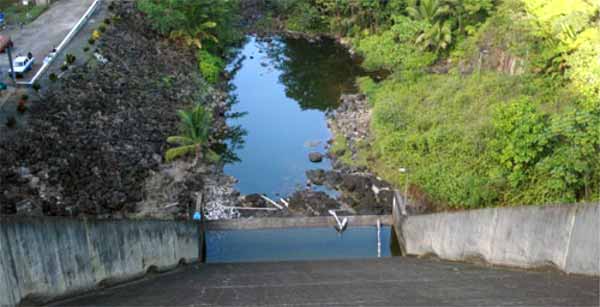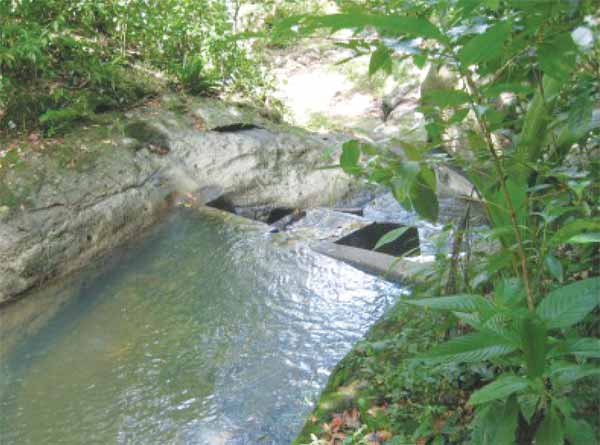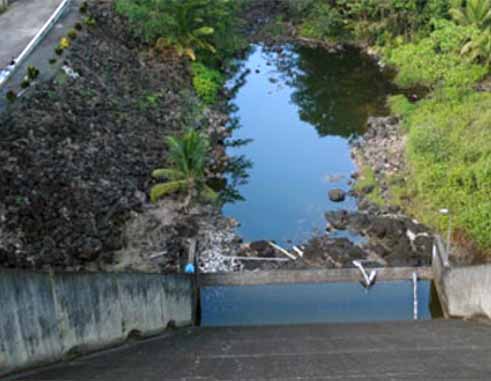By Natalie Da Breo

ON May 22 the Minister for Agriculture, Food Production, Fisheries, Co-operatives, and Rural Development acting on the advice of the Water Resource Management Agency declared that St. Lucia was experiencing a water related emergency resulting from an exceptional shortage of rain. At the end of that month measuring stations in Vieux Fort and Castries recorded 11.6 and 17 millimetres of rain respectively, justifying the government’s drought assessment.
In fact the total of 28.6 millimetres of rain recorded in May this year is 33.5 millimetres less than the amount recorded during the same period last year and the lowest amount on record for the month of May. Significantly, however despite this trend, records at the meteorological office which date as far back as 1967 at George F. L. Charles Airport and 1973 at Hewanorra International Airport do not show a consistent or continuous long term decline in annual or monthly rainfall on the island.
The devil though is in the details. Meteorological authorities point out that while annual rainfall levels continue to be fairly consistent, patterns have changed. Statistics show a high frequency of days without rain and heavier rainfall than before. Predictions from international weather experts and climate change specialists who analyse the mutating character and function of the international weather system also warn that weather emergencies associated with these changes will increase in frequency. Adaptation specialists encourage small island state governments and their populations to make adjustments to reduce the impact of the changing trends.
The drought officially ended last week but the metrological office reports that rainfall will likely be below normal during August, September and October. For the Water and Sewerage Company (WASCO) where the water spillway level of 333 feet at the Roseau Dam continued to be breached only recently, the headache may continue. Even as recently as Tuesday last week with the dam level at a disturbing six feet below the ideal, WASCO was abstracting more water than it was harvesting, there was no immediate plan to suspend the water rationing system on island and we were feeling it at our pipes.

The result of the water shortage is that frustration often gets the better of logic and the water authority becomes the subject of a tirade of public criticism. On Friday engineers from WASCO travelled to Roseau, Ravine Poisson and Vanard to do assessments on the impact of Thursday’s rains. Despite the torrents, Managing director of the Water and Sewerage Company Vincent Hippolyte points out that an outpouring of rain is “no indication that we are out of drought”. WASCO officials are due to meet with the WRMA, the Meteorological Services and other relevant technical organizations to discuss developments soon. In the meantime the public is urged to consume water responsibly.
The director of Meteorological Services and Chairman of the Flood and Drought Hazard Mitigation Committee Venantius Descartes has reminded the media that the weather system ultimately affects all human activity.
True but we can adapt.
As Climate Change is an evolving phenomenon, expectations are that policies will be developed and enhanced, legislation amended with new papers tabled, and departments will be better equipped with a greater number of scientifically trained personnel and emergency response specialists. Ultimately government must take the lead but resource management authorities insist that we all have a responsibility to respond to the risks.
Aly Anthony, Senior Manager of Operations at WASCO, cautions that water conservation has its limitations because when rain doesn’t fall, tanks dry up and the water supply is cut off. Therefore while rainwater harvesting is encouraged, WASCO also promotes a culture of economy in water consumption. Amongst the practices endorsed for the domestic sector, are the closing off of pipes when brushing teeth and soaping during showers, reducing the flushing of toilets, recycling of waste water and shutting down lawn sprinkler systems during periods of crisis.
In the critically important tourism sector water conservation at the point of consumption is difficult to promote but authorities endeavour to do so to the extent that they can. The Water Resource Management Agency for example, makes presentations to tourism based organizations on resource capacity and its effective use. Some hotels supplement their water supply with a water reserve system and at Sandals Grande on Pigeon Island there is a reverse osmosis plant which helps reduce the demand at WASCO.
With the hotels, and the commercial sector however, an economic dynamic changes the equation. WASCO’s financial woes cannot be solved with the revenue stream from the unprofitable residential sector. Hotels which are billed at a significantly higher tariff provide much needed revenue to help sustain WASCO’s operations. In 2013 and 2014, 318626 and 338,158 visitors arrived in St. Lucia respectively. Their high demand for our fluid resource converts into liquidity for WASCO which it can then use to finance the cost of its operations and capital investments for the benefit of the residents of this island. At the Roseau Dam where WASCO cannot access water from the lower pot because it is covered with 3.5 metres of sediment, money will be spent to finance dredging soon.
Major spin off benefits of tourism on our island are harnessed through linkages with the agricultural sector which is a major consumer of water. As production levels and yield are dependent on rainfall and water availability, farmers are most regularly and directly affected by the vagaries of the international climatic system. When the rains don’t come, production levels decline, leading the hotels to depend heavily on imported produce.

Residents on the island are negatively affected as well. Scarcity leads to higher prices and limited availability of nature’s best. Concerns have been raised in the health sector where local food is used to control diabetes and hypertension. The St. Lucia Diabetic and Hypertensive Association encourages its clients to buy locally grown food instead of processed foods and genetically modified produce from abroad but its Executive Director George Eugene complains when low production quantities result in prohibitively high prices.
Fortunately, with assistance of the Ministry of Agriculture, the Caribbean Agricultural Research and Development Institute, the Inter-American Institute for Cooperation on Agriculture and others, new agricultural practices have been introduced to farmers that should ultimately affect prices. Although the farming sector recorded $5,273,182.00 worth of losses as a result of last year’s drought and more losses are expected in 2015, Director of Agriculture Dr. Felix Jaria argues that it could be worse.
He reports that government has made one hundred and twenty, 1000 gallon water tanks available to crop and livestock farmers through the Banana Accompanying Measure (BAM) Project for rainwater harvesting, and granted concessions to farmers for the purchase of irrigation supplies.
Fortunately, reports are that farmers are responding positively.
General Manager at the Belle VueFarmers Cooperative Raphael Felix says that farmer skepticism and reluctance have been replaced by education and information resulting in stable production levels even during periods of drought. The Cooperative which has 189 active members, markets short crops and fruits to hotels, restaurants and supermarkets across the island. Members have been introduced to Climate Smart Agricultural practices like grass mulching which retains soil moisture and drip irrigation which is more resource efficient than the traditional sprinkler system. This has resulted in increased productivity, under more difficult conditions, using less land space.
Still, farmers are being called upon to deepen their commitment to the public interest. On the east coast in particular, many farmers draw water from streams into dams and use pumps to get water to their fields. In principle the practice is accepted but the law requires them to apply to the WRMA for abstraction licenses at no cost and so far the Agency reports that it has received only one application from the farming sector.
Decisions regarding the issue of licences are made on the basis of hydrology and ecology as well as water demand and availability in the area. Our information is that cooperation has not been forthcoming but farmers are not the only delinquents. Construction companies and others in the commercial sector are also reluctant to apply. This is partly due to the cost factor. Licenses for medium and large non-farming abstractors cost $5000 and $20,000 respectively. The law does not make allowance for small abstractors. The result is that water abstracted from rivers and streams is unregulated at this time. Reform of the legislation to give the WRMA a stronger hand for enforcement, may need to be coupled with amendments for re-categorization and pricing.
Legislation needs to be strengthened in other areas of water management as well. Reliable sources inform us that 80% of the 33 pig pens in the Dennery area are draining into the river at the Fond D’or watershed. The Forestry Department does not have sufficient power under the relevant Act to deal decisively with this risk.
The good news is that the Department of Public Health which conducts regular bacteria analyses and weekly chlorine residual tests at various sampling points across the island, reports that our local water quality is generally good. With the Department of Forestry only able to protect our water flow from contamination within the forest reserve, this is no small wonder.
Representatives of the government of St. Lucia will travel to the United Nations Climate Change Conference in Paris, France in December this year mandated by the Prime Minister to press for an agreement that contains “provisions for supporting the adaptation needs of vulnerable developing countries, like ours, including provision of adequate, predictable, new and additional finance, technology and capacity building support, and strengthening of the institutional arrangements’.
But climate change adaptation cannot be accomplished solely with finance and technical assistance. With a specific emphasis on the problem of drought, a public commitment from each citizen is central to mitigating the impact of disasters. Even when for example, planning regulations do not compel home owners to design water storage systems as part of their house plans, home owners should do so because in the context of the risks we face, it makes the most sense. That way, in honouring our civic duties, we will be ahead of the legislation and prepared for the next drought.













